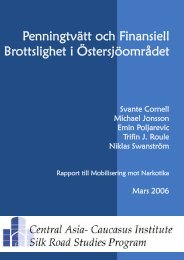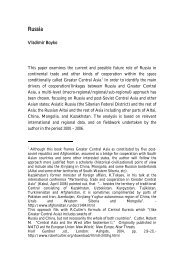Eurasianism and the Concept of Central Caucaso-Asia
Eurasianism and the Concept of Central Caucaso-Asia
Eurasianism and the Concept of Central Caucaso-Asia
You also want an ePaper? Increase the reach of your titles
YUMPU automatically turns print PDFs into web optimized ePapers that Google loves.
32<br />
Eldar Ismailov <strong>and</strong> Vladimer Papava<br />
replaces rights with duties, generally accepting <strong>the</strong> use <strong>of</strong> <strong>the</strong> former at best<br />
only with respect to those legal issues that are easier to regard from <strong>the</strong><br />
viewpoint <strong>of</strong> rights. 68<br />
It comes as no surprise that from <strong>the</strong> Eurasianists’ viewpoint, a civil society<br />
helps to intensify separatist trends <strong>and</strong> hinders real unification <strong>of</strong> <strong>the</strong> peoples<br />
<strong>of</strong> Russia (that is, Eurasia). Rejecting <strong>the</strong> notion <strong>of</strong> a civil society, <strong>the</strong><br />
Eurasianists <strong>of</strong>fer “Eurasian centralism” instead as a combination <strong>of</strong> <strong>the</strong><br />
strategic integration <strong>and</strong> diversity <strong>of</strong> <strong>the</strong> autonomous entities <strong>of</strong> Russia-<br />
Eurasia. 69<br />
It is not hard to see that <strong>the</strong> Eurasianist vision <strong>of</strong> <strong>the</strong> relations between<br />
people, society, <strong>and</strong> <strong>the</strong> state proceeds from <strong>the</strong> need for a strong state that<br />
relies on a wide range <strong>of</strong> civil servants <strong>and</strong> on <strong>the</strong> preservation <strong>of</strong> patriarchal<br />
institutions. 70 The Eurasianists put special emphasis on <strong>the</strong> problem <strong>of</strong><br />
considering federalism as part <strong>of</strong> <strong>the</strong> state structure. 71 They are convinced<br />
that autonomy implies self-government <strong>and</strong> should exclude all attributes <strong>of</strong><br />
statehood. In so doing, <strong>the</strong> size <strong>of</strong> autonomous entities may fluctuate from a<br />
few families to an entire nation. Based on <strong>the</strong> same logic, smaller<br />
autonomous entities may belong to larger ones. In terms <strong>of</strong> type, autonomous<br />
entities can be national, ethnic, <strong>the</strong>ocratic, religious, cultural-historical,<br />
social-industrial, economic, linguistic, <strong>and</strong> communal. Unpopulated or<br />
scarcely populated territories, if <strong>the</strong>y have no communities, may be declared<br />
federal l<strong>and</strong>s. Autonomous entities are delegated <strong>the</strong> functions <strong>of</strong> courts, lawenforcement<br />
structures, public administration, <strong>and</strong> control. Within <strong>the</strong><br />
Eurasian expanse <strong>the</strong>re should be no concept <strong>of</strong> border. Instead <strong>the</strong>re should<br />
be only a concept <strong>of</strong> “limit,” a border without legal force <strong>and</strong> that is not to be<br />
fixed. Keeping in mind <strong>the</strong> uneven economic development in Russia-Eurasia,<br />
68<br />
A.G. Dugin, “Teoriia evraziyskogo gosudarstva” [The Theory <strong>of</strong> <strong>the</strong> Eurasian<br />
State], in A. Dugin, ed., Osnovy Evraziystva, pp. 525-528.<br />
69<br />
A.G. Dugin, “Proekt “grazhdanskoe obshchestvo” kak ugroza rossiyskoy<br />
samobytnosti” [The “Civil Society” Project as a Threat to <strong>the</strong> Russian Identity] in A.<br />
Dugin, ed., Osnovy Evraziystva, pp. 604-605.<br />
70<br />
Boris Orlov, “Neizbezhnost’ evraziystva—neizbezhnost’ tupika” [Inevitable<br />
<strong>Eurasianism</strong>—Inevitable Dead End], Nezavisimaia gazeta, May 12, 2001,<br />
.<br />
71<br />
Alex<strong>and</strong>er Dugin, Proekt “Evraziia” [The “Eurasia” Project] (Moscow: Eksmo,<br />
Yauza, 2004), pp. 208-215.






